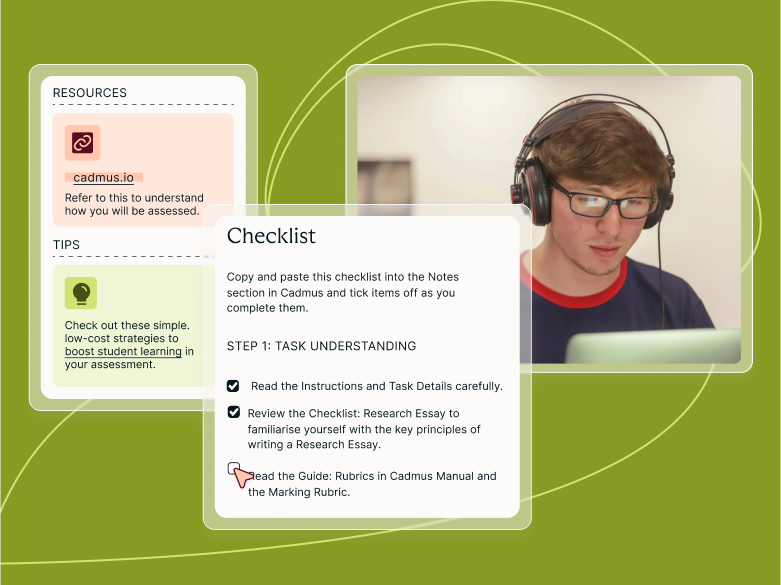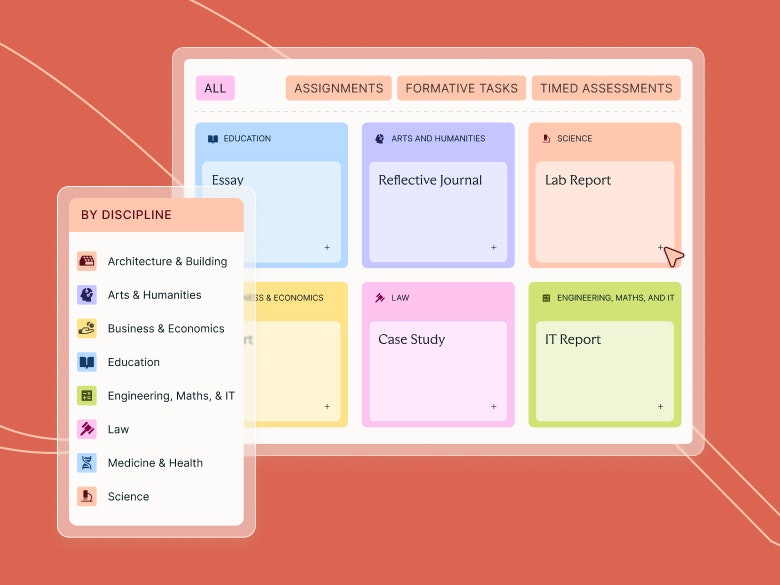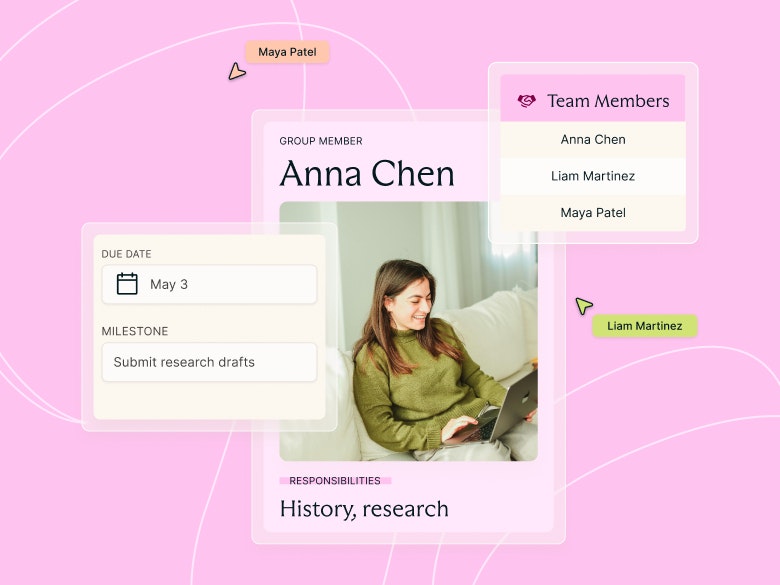Teaching guides
Provide Extra Support with Resources

Share with colleagues
With diverse classes, backgrounds and skill levels, we can't always guarantee that students have all the prerequisite knowledge needed to complete the assessments we set them. With a well-designed assessment, one way we can supplement student knowledge is by using resources. Resources form a part of the instructional scaffolding strategies we use to guide students through a learning process. They often provide students with more than just discipline knowledge, helping students develop other component or metacognitive skills.

The resources you include in your Cadmus Assignment could be anything from a video on how to use a library database, to a guide on writing newspaper editorials—it's really up to you. Ideally, the resources you share should reflect your own pedagogical beliefs and understanding of your students' needs.
Whatever topic or form they may take, the goal of sharing resources should be to encourage students to support their own learning independently. As students become more comfortable referring to and seeking out helpful content, we see a decrease in their reliance on teachers for support.
What resources should you be sharing?
While there's no real right or wrong here, there are a few resources we'd recommend always including. They ensure your assessment stays learning-centred, helping students understand expectations and develop skills.
Rubrics and grading criteria
Rubrics indicate expectations across the different aspects of an assignment (UNSW Teaching). They provide students with an understanding of varying levels of performance, showing students where it is important to focus their efforts. Rubrics are essential in helping students self-regulate as they work, and in providing them with a framework to understand the feedback they receive.
Tip: Link skills-related guides directly into your rubric. This way, students can understand how they are being assessed, while being provided with guidance around how to achieve specific skills.
For students to get the most out of rubrics, it can be helpful to provide them with guidance on how to interpret and use rubrics for learning. Your university's academic skills unit may have a resource available, or you can create your own—there are plenty of online resources to give you a head start.
Exemplars
Providing students with samples of work gives them a point of reference for high-quality work. By pairing these with the grading criteria, exemplars can help students develop evaluative judgement and a deeper understanding of how they are progressing. Keep in mind: the resources you share can also connect to learning activities in class. Your students may benefit from time in class spent reviewing an exemplar alongside the marking rubric with your guidance, giving them an opportunity to practice their evaluation skills.
Skills guides
Skills guides help students develop component skills that can be applied across assessments and subjects. These could cover specific academic skills (e.g. How to read critically or Note-taking techniques) or provide more high-level guidance (e.g. How to write a case study or Structuring lab reports). When considering what additional guides you could add, a good place to begin is by asking yourself:
- What skills do students need to develop?
- What are the component skills involved in developing these higher-level skills?
- Where are the gaps?
Your learning outcomes and experience with previous classes will help you answer these questions. Similarly, discussing them with students can help reveal areas where students have identified they need support.
"Students in Lois Balmer's class didn't know how to write sections of a Lab Report, so she created targeted resources to support them." Read the full story.
When it comes to guides about Referencing and Citations, we've got you covered. While working in Cadmus, students have access to referencing and citation guides through Cadmus Manual. They're curated according to the referencing style you set for the assignment (e.g. APA, Harvard), which means your students get contextual support automatically. Instead of attaching external guides yourself, you can encourage students to refer to the guides in Cadmus.
Assignment tips
Providing students with assignment tips is a great way to answer common questions about the task or provide general feedback to the class. You don't need to upload this resource from the get-go—instead upload it after a milestone midway through the assignment process (e.g. after a draft due date or workshop in class). These resources can help students course-correct, or even consider aspects of the assignment they've never thought about before. As an added bonus, it should also help reduce the number of student queries you receive.
Creating & curating resources
With an idea of the sorts of resources you could be sharing, it's also important to think about the format they will take. Since there will be multiple learning styles in your classroom, it can be helpful to use a range of media and techniques to ensure inclusivity in your teaching (UMass Dartmouth). Videos, podcasts, images and written guides are all examples of valuable patterns for communicating information to students in different ways.
For example: You can upload a written guide on performing library database searches, as well as a video tutorial—satisfying a wide group of students.
While the cost in creating resources may be of concern, putting a bit of time in now to create and curate resources pays off in the long run. You can continue using resources across all future assignments, making improvements as you go. Begin by looking at your university’s library or academic skills department, otherwise for more generic resources a quick search online will lead you to information you can adapt.
It's also important to consider your students’ experience engaging with the assessment. Opening an assignment to see a long list of resources can be overwhelming, often meaning that students will tune out. Try to keep the most important resources at the top (rubrics!) as we’ve seen these are the resources students engage with most.
75% of teachers add between 1 and 4 resources to their Cadmus Assignments
Timing & feedback
When it comes to sharing resources, it's best to be flexible in your approach. You don't have to share everything at once, as it's easy to update your instructions in Cadmus. We'd recommend sharing resources with students progressively where possible, giving them information relevant to their current stage of the assessment.
Tip: With Insights in Cadmus, you can track engagement with specific resources throughout the course of an assessment. If engagement is lower than expected, talk to your students in class so they understand how to benefit from the resources.
Similarly, by staying open to feedback from students, you can understand what resources they find valuable and what areas they still need support in—helping you better assist students at their points of need.
Category
Hybrid Learning
Student Success


